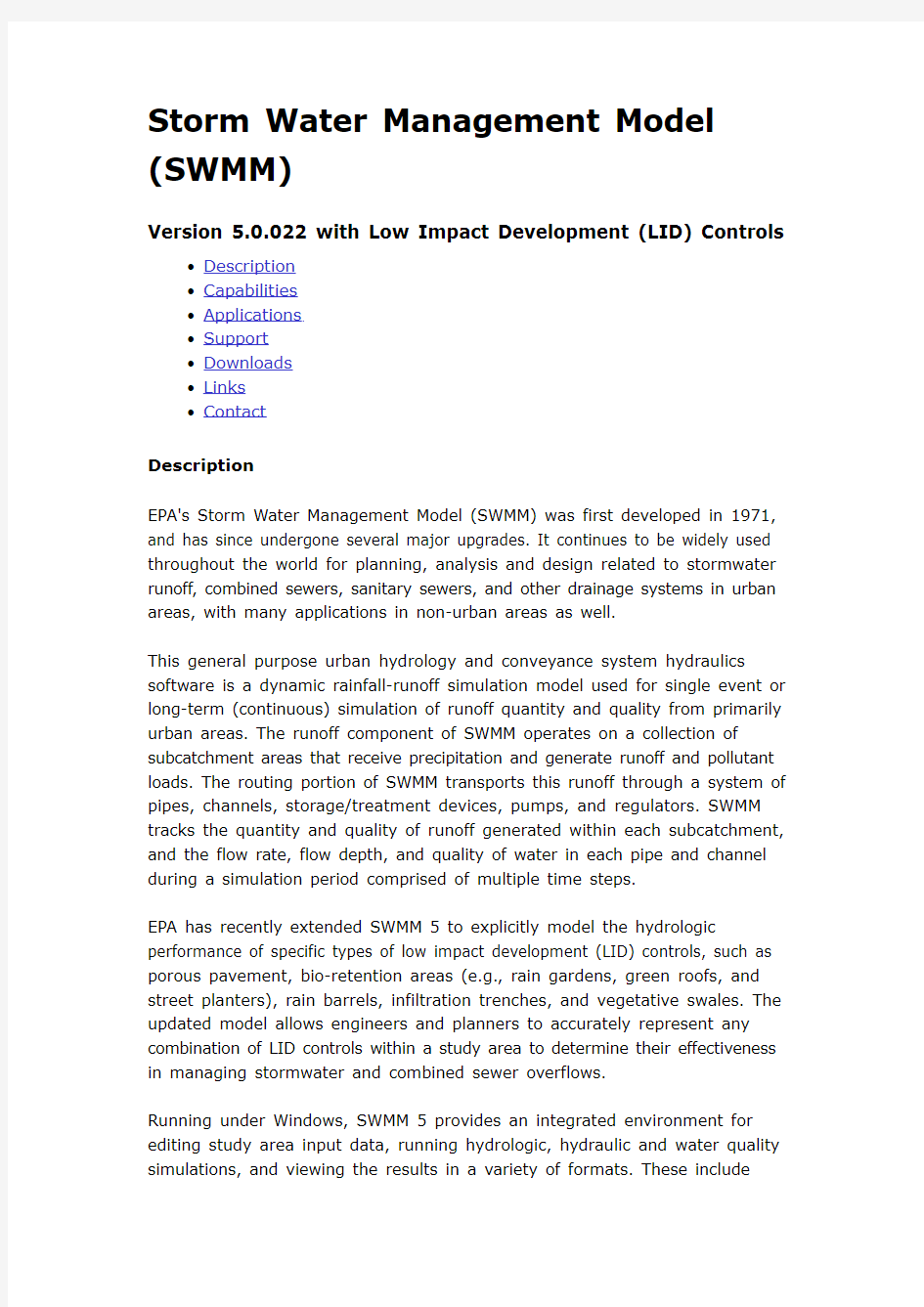SWMM


Storm Water Management Model (SWMM)
Version 5.0.022 with Low Impact Development (LID) Controls
?Description
?Capabilities
?Applications
?Support
?Downloads
?Links
?Contact
Description
EPA's Storm Water Management Model (SWMM) was first developed in 1971, and has since undergone several major upgrades. It continues to be widely used throughout the world for planning, analysis and design related to stormwater runoff, combined sewers, sanitary sewers, and other drainage systems in urban areas, with many applications in non-urban areas as well.
This general purpose urban hydrology and conveyance system hydraulics software is a dynamic rainfall-runoff simulation model used for single event or long-term (continuous) simulation of runoff quantity and quality from primarily urban areas. The runoff component of SWMM operates on a collection of subcatchment areas that receive precipitation and generate runoff and pollutant loads. The routing portion of SWMM transports this runoff through a system of pipes, channels, storage/treatment devices, pumps, and regulators. SWMM tracks the quantity and quality of runoff generated within each subcatchment, and the flow rate, flow depth, and quality of water in each pipe and channel during a simulation period comprised of multiple time steps.
EPA has recently extended SWMM 5 to explicitly model the hydrologic performance of specific types of low impact development (LID) controls, such as porous pavement, bio-retention areas (e.g., rain gardens, green roofs, and street planters), rain barrels, infiltration trenches, and vegetative swales. The updated model allows engineers and planners to accurately represent any combination of LID controls within a study area to determine their effectiveness in managing stormwater and combined sewer overflows.
Running under Windows, SWMM 5 provides an integrated environment for editing study area input data, running hydrologic, hydraulic and water quality simulations, and viewing the results in a variety of formats. These include
color-coded drainage area and conveyance system maps, time series graphs and tables, profile plots, and statistical frequency analyses.
SWMM 5 was produced in a joint development effort with CDM, Inc., a global consulting, engineering, construction, and operations firm.
Top of page
Capabilities
SWMM accounts for various hydrologic processes that produce runoff from urban areas. These include:
?time-varying rainfall
?evaporation of standing surface water
?snow accumulation and melting
?rainfall interception from depression storage
?infiltration of rainfall into unsaturated soil layers
?percolation of infiltrated water into groundwater layers
?interflow between groundwater and the drainage system
?nonlinear reservoir routing of overland flow
?runoff reduction via Low Impact Development (LID) controls.
Spatial variability in all of these processes is achieved by dividing a study area into a collection of smaller, homogeneous subcatchment areas, each containing its own fraction of pervious and impervious sub-areas. Overland flow can be routed between sub-areas, between subcatchments, or between entry points of a drainage system.
SWMM also contains a flexible set of hydraulic modeling capabilities used to route runoff and external inflows through the drainage system network of pipes, channels, storage/treatment units and diversion structures. These include the ability to:
?handle drainage networks of unlimited size
?use a wide variety of standard closed and open conduit shapes as well as natural channels
?model special elements such as storage/treatment units, flow dividers, pumps, weirs, and orifices
?apply external flows and water quality inputs from surface runoff, groundwater interflow, rainfall-dependent infiltration/inflow, dry
weather sanitary flow, and user-defined inflows
?utilize either kinematic wave or full dynamic wave flow routing methods
?model various flow regimes, such as backwater, surcharging, reverse flow, and surface ponding
?apply user-defined dynamic control rules to simulate the operation of pumps, orifice openings, and weir crest levels
In addition to modeling the generation and transport of runoff flows, SWMM can also estimate the production of pollutant loads associated with this runoff. The following processes can be modeled for any number of user-defined water quality constituents:
?dry-weather pollutant buildup over different land uses
?pollutant washoff from specific land uses during storm events
?direct contribution of rainfall deposition
?reduction in dry-weather buildup due to street cleaning
?reduction in washoff load due to BMPs
?entry of dry weather sanitary flows and user-specified external inflows at any point in the drainage system
?routing of water quality constituents through the drainage system
?reduction in constituent concentration through treatment in storage units or by natural processes in pipes and channels
Top of page
Applications
Since its inception, SWMM has been used in thousands of sewer and stormwater studies throughout the world. Typical applications include:
?design and sizing of drainage system components for flood control
?sizing of detention facilities and their appurtenances for flood control and water quality protection
?flood plain mapping of natural channel systems (SWMM 5 is a FEMA-approved model for NFPI studies)
?designing control strategies for minimizing combined sewer overflows ?evaluating the impact of inflow and infiltration on sanitary sewer overflows
?generating non-point source pollutant loadings for waste load allocation studies
?controlling site runoff using Low Impact Development practices
?evaluating the effectiveness of BMPs for reducing wet weather pollutant loadings.
Top of page
Support
There is no formal support offered for EPA SWMM. A SWMM Users Listserv, established by the University of Guelph, allows subscribers to ask questions and exchange information. To subscribe, send an email message to
listserv@listserv.uoguelph.ca with the words "subscribe swmm-users" (without the quotes) in the body followed by your name.
